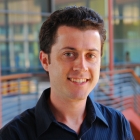You are here
Laboratory for Systems Neuroscience of Vision
The Marshel Lab is dedicated to revealing how neural circuits perform computations underlying visual perception and learned sensory behavior. We employ novel neural circuit mapping and manipulation approaches to reveal and causally test the neural circuit basis of sensory computations, i.e., how specific patterns of neural activity and connectivity influence perception and learning.
To accomplish this, we develop and apply approaches to augment and replace natural sensory input by using precise neural stimulation at the single neuron and neural ensemble population levels in awake behaving animals. We simultaneously record neural activity from thousands of surrounding neurons to measure natural activity dynamics and to map connectivity functionally in real time. See Figure 1.
The long-term goals of this work are to gain a mechanistic understanding of visual perception and sensory learning that guides future treatments in sensory loss, psychiatry, and neural circuit repair.

Figure 1. Overview of approaches. Left, population neuronal activity correlated with visual behavior is measured with calcium imaging (mouse runs on floating ball; lickport delivers water reward and measures behavioral choices). Middle, visually-tuned neuronal ensembles are identified that preferentially respond to a specific visual stimulus during behavior. Right, visual stimuli are replaced by holographic optogenetic stimulation of the tuned ensembles. Functional networks are revealed in specific neurons and cell types across cortical layers by detecting held out, unstimulated neurons that reliably respond during ensemble stimulation. This approach reveals causal impacts of activity in the stimulated ensembles on population dynamics and the sensory behavior of the animal.
The Scientific Problem
Perception is thought to arise from neural circuit computations and specific neural activity patterns. The causal links between patterns of neural activity or connectivity and perception are largely unknown. Filling this gap requires new approaches to precisely manipulate and reveal patterns of neural activity and connectivity during behavior.
Neural circuits comprise an intricate web of connections between populations of specific neurons. Precise patterns of connectivity form biological substrates to transform neural activity and compute internal representations necessary for perception and behavior. Importantly, neural circuit connectivity is highly dynamic. Not only is anatomical synaptic connectivity capable of changing over long timescales (days, months, or years) due to learning and behavioral experience, but effective connectivity between neural ensembles is highly dynamic and is strongly influenced by real-time context over minutes, seconds, or milliseconds. For example, activity in a neural ensemble in one brain region may drive activity in another ensemble only if it is coincident with input from another brain region.
Therefore, to understand the neural circuit bases of perception and behavior, it is necessary to study neural circuits in a way that reveals precise patterns of connectivity and activity and that accounts for the dynamic nature of circuit organization. Moreover, to understand the causal link between neural circuit organization, perception, and behavior, it is necessary to perturb neural circuit activity and connectivity with high precision in vivo, during behavior. However, studying neural circuits with high precision (single cell resolution), significant scale (large populations over multiple brain regions), and with information about effective connectivity over short and long timescales has been significantly limited up until now due to a lack of technological approaches.
Our Approach
To understand neural circuit computations and causally link them to perception and learned sensory behaviors, the Marshel Lab is focused on revealing and precisely manipulating neural activity and connectivity between identified populations of neurons, with single cell resolution and multi-region scale. To reveal and understand the dynamic nature of neural circuits underlying perception, the Marshel Lab develops and applies circuit mapping and manipulation approaches that can track effective connectivity involving thousands of neurons over short (seconds or minutes) and longer timescales (weeks to months).
This involves:
- Testing sufficiency, and ultimately necessity, of specific neural network activity patterns to generate predicted population dynamics and to modulate perceptual behavior, using precise neural activity manipulation technologies.
- Mapping neural circuits in vivo between ensembles of identified specific neurons, within and across regions with single cell resolution, at different stages of learning and executing sensory guided behavior.
This work aims to understand the neural circuit bases of perception and learned sensory behavior. Developing and applying novel approaches, we aim to causally test links between activity in specific neurons on effective connectivity, population dynamics, and sensory behavior. The combination of knowledge and technologies gained and developed will hopefully lead to improved treatments for sensory loss, psychiatric disorders, and novel therapeutics in neural circuit repair.
Our Environment
Sharing the excitement and challenge of scientific discovery.
We believe that the greatest scientific achievements occur in an environment that is inclusive, diverse, open, and collaborative. We strongly value creativity and diverse viewpoints from individuals who are highly motivated and take initiative. Understanding the neural circuit mechanisms of perception and behavior requires diverse and varied approaches and perspectives. This necessitates a highly collaborative environment that fosters communication and interaction between members of the lab and the greater scientific and engineering communities. We strive to be a hub for this approach to science, and to exemplify an environment of inclusion, diversity, and collaboration. We believe this creates an environment where everyone is heard and can make an impact; where new ideas are welcomed and cultivated from anyone; where we’re excited to go lab and to make discoveries together as a team.

